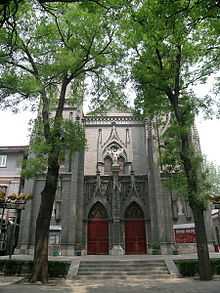Beijing Legation Quarter


The Beijing Legation Quarter was the area in Beijing, China where a number of foreign legations were located between 1861 and 1959. In the Chinese language, the area is known as Dōng Jiāo Mín Xiàng (simplified Chinese: 东交民巷; traditional Chinese: 東交民巷), which is the name of the hutong (lane or small street) through the area. It is located immediately to the east of Tiananmen Square.
Origins
During the Yuan Dynasty, the street was known as the Dōng Jiāng Mĭ Xiàng (simplified Chinese: 东江米巷; traditional Chinese: 東江米巷), or "East River-rice Lane". It was the location of the tax office and customs authorities, because of its proximity to the river port by which rice and grains arrived in Beijing from the south. During the Ming Dynasty, a number of ministries relocated into the area, including the Ministry of Rites, which was in charge of diplomatic matters. Several hostels were built for tributary missions from Vietnam, Mongolia, Korea and Burma.
Legation Quarter
Soon after China's defeat in the Second Opium War of 1856-60, the Zongli Yamen was established as a foreign office of the Qing Dynasty and the area around Dong Jiangmi Xiang was opened for a number of foreign legations.
The foreign legations were originally scattered close to the Qing imperial government in the southern part of Beijing's old inner city, just east of Tian'anmen Square and north of Qianmen and Chongwenmen. During the Boxer Rebellion of 1900, the Legation Quarter was the site of an international incident as it was besieged by Boxers for several months. After the siege had been ended by the Eight-Nation Alliance at the end of the Battle of Peking, the foreign powers obtained the right to station troops to protect their legations by the terms of the Boxer Protocol. The Legation Quarter was encircled by a wall and all Chinese residents in the area were ordered to relocate away. Sealed from its immediate environment, the Legation Quarter became a city within the city exclusively for foreigners and many Chinese nationalists resented the Quarter as a symbol of foreign dominance.
It was also a term of the Boxer Protocol that the street's name be changed to "Legation Street", with the Chinese name changed to Dong Jiaomin Xiang, a name which sounds similar to the original but can be interpreted as "Diplomatic Personnel Lane". Most of the Chinese ministries relocated their offices from the street.
During 1937, after the beginning of the Second Sino-Japanese War, most foreign legations, other than those of the Axis Powers, quit Beijing. The Legation Quarter was then officially given back to the Republic of China government.
The People's Republic
At the time of the victory of the People's Republic of China (1949), a number of foreign legations were still situated in the legation area, but after 1959 foreign missions were relocated to Sanlitun outside the old city walls.
However, the area suffered much vandalism during the Cultural Revolution. More damage was inflicted since the 1980s due to Beijing's redevelopment. Several buildings, such as the former HSBC building, were demolished for road expansion. Some buildings are occupied by government institutions. A number of modern high-rise buildings have also been built, dramatically changing the area's appearance. Nevertheless, as Beijing's most significant collection of Western-style buildings, the area is a tourist destination, is protected by municipal artifact preservation orders, and now features several fine dining restaurants and retail shops.
See also
Notes
References
- Moser, Michael J., and Yeone Wei-chih Moser. Foreigners within the Gates: The Legations at Peking. Hong Kong, New York: Oxford University Press, 1993.
External links
| Wikimedia Commons has media related to Beijing Legation Quarter. |
- Map of former Legation Quarter + Legations
- Photographs of former Legation Quarter
- Legation Quarter Website
Coordinates: 39°54′11″N 116°24′06″E / 39.90306°N 116.40167°E
